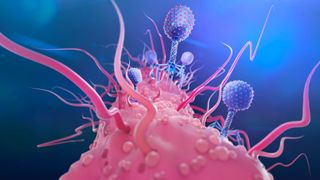Table of Contents
In the news this week, the James Webb Place Telescope built some astounding discoveries, we explored irrespective of whether an “inverse vaccine” would get the job done for human beings and scientists realized how to write in water.
The James Webb House Telescope has been active this week, snapping an image of a stunningly ideal “Einstein ring”, discovering an ancient supernova that could assistance address one particular of the universe’s major mysteries and recognizing thousands of Milky Way-like galaxies in a location they shouldn’t exist. Back again in our very own solar technique, we watched comet Nishimura get battered by a photo voltaic storm, welcomed the return of record-breaking astronaut Frank Rubio from the Global Place Station and made AI that could detect alien everyday living — even though we’re not entirely absolutely sure how it works.
In the earth of aquatic mammals, humpback whales have been preening by themselves by “kelping”, even though some opportunistic orcas have develop into victims of their newfound conduct. In more negative information for mammals, the upcoming supercontinent, Pangaea Ultima, is possible to get so scorching so speedily that mammals will not be ready to adapt. Having said that, that will never be for another 250 million years, so we’re safe for now.
The major health and fitness information this week was that experts are tests an “inverse vaccine,” which selectively suppresses the immune program. It productively handled a several sclerosis-like issue in mice, but could this new method get the job done in folks? We also observed that the antiviral drug molnupiravir may perhaps be shaping the evolution of the virus behind COVID-19. We however will not know what this suggests for transmission or the emergence of new variants, but this is not one thing we really should be amazed or apprehensive about, specialists instructed us.
Now to the historical environment, the place words from a “misplaced” language ended up discovered on an historical clay pill in Turkey. The Indo-European language would have been spoken additional than 3,000 decades back, and although scholars are even now working out what the text signify, they know it was “ritual text.” Other impressive discoveries this week had been a “pretty scarce” Bronze Age arrow with its quartzite idea even now intact and a 1,400-year-outdated tomb in China revealing proof of a royal electrical power battle.
And lastly, we get rid of light on “diffusioosmosis,” which as perfectly as staying remarkably complicated to say is very beneficial if you want to compose words and phrases on water.
Stick to us on WhatsApp
Want far more science information? Observe our Stay Science WhatsApp Channel for the hottest discoveries as they happen. It can be the very best way to get our skilled reporting on the go, but if you really don’t use WhatsApp we are also on Fb, X (previously Twitter), Flipboard, Instagram, TikTok and LinkedIn.
Photo of the week
Far more than 4,000 decades back, a youthful girl who died in what is now Scotland was buried in a crouched place inside of a stone-lined grave. She remained buried for millennia, till excavators at a stone quarry unexpectedly unearthed her bones in 1997.
Minimal is acknowledged about the lady — dubbed Higher Largie Girl after the Higher Largie Quarry — but now, a new bust-like reconstruction reveals how she may perhaps have looked for the duration of the Early Bronze Age.
“Creating a reconstruction I commonly believe that we are on the lookout into their environment, [meaning] they do not see us,” Oscar Nilsson, a forensic artist primarily based in Sweden who crafted the woman’s likeness, instructed Stay Science in an electronic mail. “I thought it could be an intriguing plan to twist this a little bit, and truly pondering that she can see us. And as you can see, she appears to be like a bit significant to us (I don’t blame her for that…)!”
If you want to see far more, examine out these other remarkable facial reconstructions that deliver the previous back again to daily life in uncanny depth.
Sunday studying
Are living Science extended examine
Viruses that break up germs open from the inside of, the well-known gene-editing device CRISPR, designer molecules and very small protein sabers — these are the picked instruments of experts searching for new techniques to get rid of dangerous bacterial “superbugs.” Traditional antibiotics drive micro organism to grow resistant to cure, and the overuse of these outdated prescription drugs has only sped the unfold of multidrug-resistant germs. In a new element, wellbeing editor Nicoletta Lanese speaks with industry experts performing on new options to antibiotics that will not push resistance. And in an accompanying story, she discusses what we can do in the meantime, even though these new medication are coming down the pipeline.

